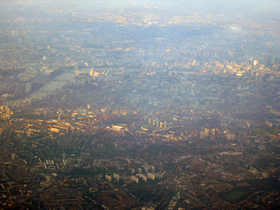London (2/2)
In London, 22% of the city's carbon-dioxide emissions are caused by surface transport. London's goal is to reduce and to minimize its CO2 production, enhance air quality and to find alternative sources of generating and supplying energy. The London plan focuses on how to apply sustainable land use and transportation.
Its plan is to create a " [...] more compact and higher-density city[...] with mixed-use and socially balanced communities, combining housing with offices, shops, leisure and entertainment, healthcare facilities, schools and colleges" (Gavron 2007, 379). " It is also required to produce an integrated transport strategy, an air quality management strategic plan, a waste management strategy, regular state of the environment reports, a strategy for culture [...] and an economic development strategy" (Thornley 2000, 29).
There are demands especially for attractive and sustainable alternatives to the car. The fastest improvement in the bus sector showed there are effective options for change. But in future projects there also needs to be a long term change in the underground and rail networks of London.
The Road Traffic Reduction Act 1997 resulted from a study of the need for a reduction of the traffic volume. On February 17th 2003 the Congestion Charge scheme was introduced in Central London, with the aim to reduce congestion and to raise, with the help of a fee of £ 8 per day, funds for investments in the London transportation system. The original zone was mostly the London Inner Ring Road but in 2007 the charging zone was extended westward and its realisation reduced CO2 emissions by 16%.
Another major road user charging scheme is the London Low Emission Zone, which was introduced on February 4th 2008. The purpose of this charging system is to reduce the pollution emissions of diesel-engined vehicles like lorries, buses, coaches, large vans and minibuses to help improve air quality in Greater London.
The plan to reduce carbon emissions by 60% by 2050 also needs a focus on London's homes, which in total account for nearly 40% of the city's emissions. At best buildings would be low or even zero emission. This means new houses need to conform to higher environmental standards, and existing social housing stocks need to be improved with insulation and new technologies for energy-conservation. There is a great need for large-scale renewable-power generation in the whole city (Burdett 2007, Gavron 2007).
The Green Home Program
The London Green Home Program was originated to support Londoners in cutting down their carbon emissions, by offering an awareness campaign, a one-stop shop on how to implement energy-saving measures and further information. This program helps not only to reduce the general carbon emission, but also gives Londoners advice on how to save money on energy bills.
London wants to be a low-carbon-city model for Europe and the world by 2025. Ever since it has been clear that a 30% reduction of carbon emissions all over the world will not be enough to prevent catastrophic climate change, every sustainable development must focus on low-carbon development. The emission reduction can only be realised by reducing the use of energy in buildings, in cutting down the carbon emission production from transport and other major producers, and the arrangement of new methods for energy supply. But the first step needs to be a behavioural change by each Londoner and all other people (Gavron 2007).
Tasks:
1. Describe one of the named plans or programs for London.
2. List the ways in which London is attempting to be a "green" city.
3. Do you think it can become a world example of good environmental practice?


